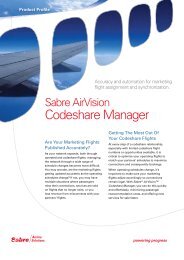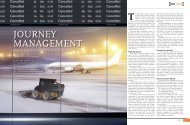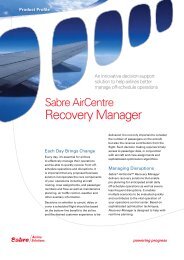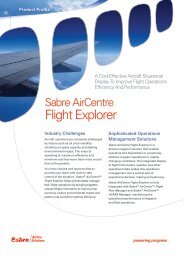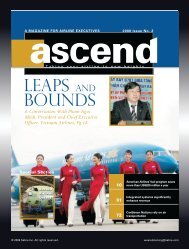2009 Issue 1 - Sabre Airline Solutions
2009 Issue 1 - Sabre Airline Solutions
2009 Issue 1 - Sabre Airline Solutions
Create successful ePaper yourself
Turn your PDF publications into a flip-book with our unique Google optimized e-Paper software.
egional<br />
22<br />
The recently completed merger of Delta<br />
Air Lines and Northwest <strong>Airline</strong>s has<br />
created the world’s largest global carrier.<br />
As part of the terms and conditions of the<br />
acquisition, the combined airline has agreed to<br />
maintain its existing hub airports for the foreseeable<br />
future, including major flight operations<br />
in Amsterdam, Netherlands; Atlanta, Georgia;<br />
Cincinnati, Ohio; Detroit, Michigan; Memphis,<br />
Tennessee; Minneapolis-St. Paul, Minnesota;<br />
New York City, New York; Salt Lake City, Utah;<br />
and Tokyo, Japan.<br />
In addition, the two carriers will continue<br />
to operate independently during the transition<br />
process, until they can be merged onto a single<br />
U.S. Department of Transportation operating<br />
certificate. This process is anticipated to take 12<br />
to 18 months to fully complete. In the interim,<br />
it’s business as usual for the two carriers that,<br />
together, maintain partnerships with 10 regional<br />
carriers.<br />
While three of these carriers are direct<br />
subsidiaries of the new, combined carrier, Delta<br />
Air Lines’ relationship with the remaining regional<br />
carriers is governed by capacity purchase agreements<br />
that involve a fixed fee for departure or<br />
cost-plus contract.<br />
As part of these agreements, regional<br />
carriers are usually restricted to operate a limited<br />
number of aircraft below an agreed-upon seat<br />
capacity and on specific routes through specific<br />
pilot scope clauses, and they are in effect under<br />
the strategic control of the network carrier.<br />
Under these capacity purchase agreements, the<br />
network carrier assumes all the market risk and<br />
is responsible for commercial planning, revenue<br />
management, marketing, sales and distribution<br />
of the airline product. It usually covers high-risk<br />
items such as aircraft ownership and insurance<br />
as well as fuel costs. The regional carrier is<br />
responsible for operating the flights and ensuring<br />
the availability of capacity for the network<br />
airline.<br />
Leading up to the merger, Delta Air Lines<br />
had proactively reviewed its existing agreements<br />
with each regional carrier and opted<br />
to terminate operations entirely with Big Sky<br />
<strong>Airline</strong>s and ExpressJet <strong>Airline</strong>s as well as significantly<br />
reduce its dependence on Freedom<br />
<strong>Airline</strong>s (subsidiary of Mesa Air Group). While<br />
Delta Air Lines’ original intent was to remove<br />
non-beneficial partnerships, it was also able to<br />
reduce the number of partner carriers and retire<br />
less-desirable aircraft from its fleet — primarily<br />
small regional jets (50 seats or less).<br />
Throughout the course of last year’s<br />
damaging economic downturn and simultaneous<br />
escalation of fuel prices, U.S. domestic<br />
major network carriers started to re-evaluate<br />
the benefits of regional operations in their<br />
network systems. While Delta Air Lines’ and<br />
Northwest <strong>Airline</strong>s’ review may have been<br />
accelerated by their pending merger, the<br />
remaining network carriers also took a hard<br />
look at their partnerships.<br />
ascend<br />
In the majority of the cases, the major<br />
network carrier was able to obtain more-favorable<br />
capacity purchase agreements as well<br />
as place a greater level of financial risk on the<br />
regional carrier. In the end, the stronger regional<br />
carrier groups such as Republic <strong>Airline</strong>s and<br />
SkyWest <strong>Airline</strong>s were able to re-enforce their<br />
position as marquee regional partners with their<br />
existing network partners as well as pick up<br />
some additional flying lost by smaller and often<br />
less-financially stable regional airlines. It was<br />
essentially a matter of the strong getting stronger<br />
and the weak getting weaker or, in some<br />
cases, ceasing operations altogether.<br />
The jury is still out on what will happen to<br />
the remaining independent regional carriers, but<br />
many believe that they will either be acquired<br />
by their stronger counterparts and/or join forces<br />
together to counteract the negotiating power of<br />
their network partners.<br />
As the level of regional carrier operations<br />
increases for a given network carrier, the thorny<br />
issue of which ones will fly next-generation<br />
larger regional aircraft (70 seats or more) surfaces.<br />
Most network carriers are still restricted<br />
by scope clauses in their pilot contracts, and<br />
they have found creative ways to deal with the<br />
situation by introducing first-class cabins on<br />
the merger between Delta Air lines and Northwest <strong>Airline</strong>s, which has created the world’s<br />
largest airline, has significant benefits for regional partners such as compass <strong>Airline</strong>s<br />
operated by Northwest <strong>Airline</strong>s and comair serving Delta connection.<br />
Photo courtesy of Bombardier<br />
Photo courtesy of Northwest <strong>Airline</strong>s




